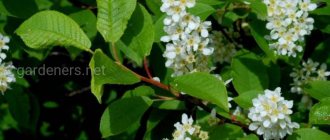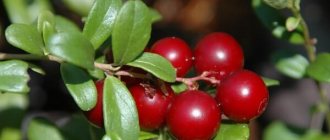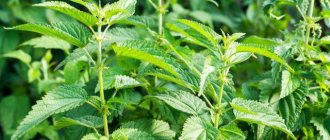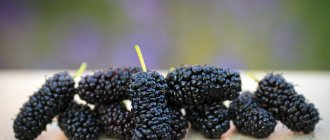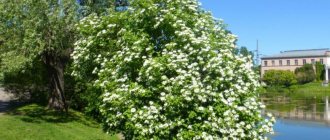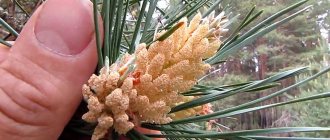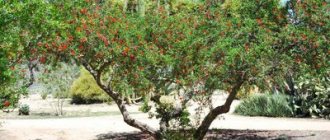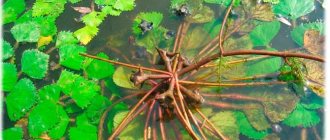Bird cherry is a flowering ornamental tree that belongs to the Rosaceae family. Relatives of bird cherry are cherry, black cherry, plum, peach, almond and other stone fruit trees, which belong to the plum subfamily. There are about 20 varieties of bird cherry, including tree and shrub forms. Bird cherry is widespread in Europe, North America and Central Asia. All species combine plant varieties that are grown for decorative purposes or for fruit production.
Common bird cherry or raceme
This bird cherry is also called bird cherry - it is found naturally in the forests of Eurasia. This is a tree-like plant, rarely represented by shrubs, growing up to 18 meters in height. The foliage of bird cherry is greenish in color with a hint of blue, in the lower part it is bluish. By autumn, the leaves turn yellow, carmine or purple. The tree blooms every year in mid-spring. The fruits of the tree are small, about 0.5 cm in diameter, dark in color with shine, and sweetish.
The most popular variety of bird cherry is “Colorata”. This is a shrubby plant, growing up to 5 meters in height. The leaves are lilac or reddish in spring, but turn green by June. Bird cherry inflorescences are large, pinkish, and smell aromatic like almonds. The branches and bark of the plant are purple in color. The shrub needs good lighting and high humidity, and is resistant to low temperatures. The fruits ripen at the end of summer.
Interesting varieties of common bird cherry:
- pendula – weeping crown;
- pyramidalis – crown in the form of a pyramid;
- roseiflora – pinkish flowers;
- plena – double flowers;
- leucocarpa – yellowish colored fruits;
- aucubaefolia - leaves are strewn with small yellow spots.
Growing bird cherry
Planting and propagation
Bird cherry is propagated by seeds, shoots, layering and cuttings. To propagate by cuttings, they are cut in the spring at the time of sap flow and planted for rooting.
Bird cherry is propagated by sowing seeds in August–September (the properties of the mother plant are not preserved). If you did not have time to sow in the fall, then the seeds are stratified for 4 months, and in some species up to 7-8 months (common bird cherry, Maaka bird cherry, late bird cherry). They are buried in clean, damp sand poured into a container and placed in a cool place. And when the seeds begin to hatch, the container is immersed in snow. Usually, under the crowns of fruit-bearing plants, as a result of self-seeding, many seedlings are formed, which can be planted in a permanent place at the age of two.
Bird cherry seedlings take root well both in autumn and spring. The hole for the seedling should be of such a size that the roots can freely fit in it. Apply mineral fertilizers according to the usual scheme indicated on the package, and organic fertilizers, but do not overdo it with the latter. Their excess and high soil moisture can lead to darkening of the wood and drying out of individual branches. Water the plants generously during planting and then 2-3 times during the growing season.
In the future, it is better to water only during drought. Mulch the soil with sawdust, humus or cover with film. When planting, it is necessary to take into account the height of the plants, their dense crown, which provides a lot of shade. Since most varieties are cross-pollinators, it is better to plant several varieties on the site. In this case, ordinary bird cherry is planted at a distance of 4–6 m from each other, and Virginia bird cherry – at a distance of 3–4 m.
When planting, prune the plants at a height of 60 cm so that they lay low on the first skeletal branches. Next year, cut off the leader shoot at a height of 50-60 cm from the first tier of skeletal branches - then the second tier will form, etc.
Bird cherry (Prunus maackii). © Wouter Hagens
Bird cherry care
Although bird cherry is unpretentious, it grows and develops better in well-lit areas with nutritious, moderately moist soil. Mature trees provide a lot of shade - this must be taken into account when creating compositions.
For abundant fruiting, it is better to plant at least two plants of different varieties, but blooming at the same time: the self-fertility of bird cherry leaves much to be desired, cross-pollination is desirable and even necessary.
Maaka and syori bird cherry trees, accustomed to the humid Far Eastern climate, do not tolerate excessive dry soil - they should be watered abundantly as needed, avoiding compaction and drying out of the soil around the trunk.
Caring for bird cherry consists of digging and loosening the soil, applying root and foliar fertilizers, removing weeds, formative and sanitary pruning.
Plants can be formed either on a high trunk or in the form of a multi-stemmed shrub. To establish a low first tier of skeletal branches, the seedling is cut at a height of 60–70 cm. Of the emerging side shoots, 3–4 of the most developed ones are left, evenly oriented in space. In subsequent years, tiers of the second and third orders are formed.
Bird cherry (Prunus padus). © Udo Schröter
Bird cherry virginia
In their natural environment, representatives of the species live in North America. The tree grows up to 15 meters in height, sometimes represented by a medium-sized shrub, about 5 meters high. The plant blooms at the end of spring, the aroma is not noticeable. The fruits of the tree are reddish in color, about 0.5-0.8 cm in diameter, and can be eaten. The inflorescences are white, the foliage of the plant is reddish-burgundy. The tree is resistant to low temperatures and hot, dry weather, but needs lighting and watering. This species is divided into several forms, which differ in the color of the fruit (yellowish, black and cherry). The tree may be low or have drooping branches.
Interesting varieties of Virginia bird cherry:
- nana – low-growing shrub;
- pendula – a plant with a weeping crown;
- rubra – cherry-colored fruits;
- xanthocarpa – yellowish fruits;
- melanocarpa – black fruits.
Diseases and pests
The main diseases of bird cherry are leaf spot and fruit disease, which is caused by marsupial fungus . If such signs appear, you need to remove the affected parts of the tree.
Common pests include aphids, weevils, bedbugs, moths and silkworms .
To destroy them, in early spring the tree is treated with tobacco infusion or soap solution. After flowering ends, repeat the treatment.
Also, for good flowering, you can spray with a solution of Sherpa or Decis.
It is believed that bird cherry is an air purifier because it releases volatile phytoncides and also repels mosquitoes and ticks. But it is not recommended to bring branches indoors; headaches may begin, especially for people with allergies.
Late bird cherry
It is found naturally in North America and has taken root in the temperate conditions of our region. This is a strong flowering tree, growing up to 30 meters in height. The leaves are rich green in summer, but turn yellowish-red in autumn. Blooms in late spring or early summer. The bark of the tree is black, the fruits are also dark in color, large, no more than 1 cm in diameter. The fruits can be eaten, are bitter, and ripen by autumn. The tree is self-fertile with a well-developed root system, resistant to low temperatures.
Use in cooking
Bird cherry is widely used in cooking. The berries are inferior in taste to their relatives - cherries, cherries and plums due to their slightly astringent taste and sourness, but they are healthy for the body and aromatic.
Dried berries are ground into flour . Used as an additive to bakery products. The baked goods acquire a delicate delicate aroma.
Use:
- a cake is baked from bird cherry flour;
- make delicious bird cherry kvass;
- tinctures and liqueurs are made on its basis;
- fresh berries are an excellent filling for pies;
- make jelly, fruit drinks, syrups;
- young leaves can be used for salads;
- make tea;
- making jam.
Bird cherry is especially valuable for northern regions , where berries that can be grown in temperate latitudes cannot ripen.
Bird cherry is widespread throughout our country. It pleases with its flowering and delicate aroma. Used in medicine and cooking . Gardeners are planting new varieties. Decorative tree species are used in landscape gardening. Poets and writers wrote about bird cherry with warmth and love.
Pennsylvania bird cherry
The natural habitat of the species is North America, and has adapted to the climatic conditions of our regions. The tree is found in forests and near water bodies. The plant is presented in the form of an upright tree or bush, growing up to 12 meters in height. The bark of the shoots is cherry in color; on young shoots it is brighter and shiny. The crown of the tree is loose, oval-shaped. Bird cherry leaves are elongated-lanceolate, green in spring, and red in autumn. The inflorescences are large and white. The plant bears fruit three years after planting. The berries are small and red. The tree is resistant to low temperatures and droughts, unpretentious to the composition and condition of the soil. The roots produce dense growth. Bird cherry tree bears pruning painfully. Flowering and fruiting are abundant. During the first 10 years, tree growth is more active, but later it becomes slower. When planting, due to the growth of the root system, it is recommended to limit the roots with slate, plastic or metal sheets.
Healing properties of wood
Healers in ancient times knew about the healing properties of the plant, which are contained in the bark, leaves and berries.
Therefore, they were actively used for treatment:
- phytoncides , which are contained in tree bark, were used in the form of decoctions or made tinctures. The bark was removed in thin strips in the spring. Used as an anti-inflammatory, anti-fever and diaphoretic. Tinctures help well with rheumatism.
The bark and leaves contain hydrocyanic acid, so you need to be extremely careful in dosages.
- For lung diseases, a decoction of leaves and flowers is useful. An infusion of flowers treats the mucous membranes of the eyes. The bark is used to treat rheumatism;
Bird cherry decoction
- The fruit is a storehouse of vitamins and beneficial elements . Vitamins P, the so-called flavonoids, strengthen the walls of blood vessels. Amygdalin (B17, most abundant in bones) is used as an antitumor and anticancer substance. Sugars, citric acid, ascorbic acid, malic acid, essential and fatty oils (in the seeds), mineral elements, including molybdenum and titanium, are contained in the fruits. Therefore, they are used as a restorative remedy for many stomach diseases and colds. Tannins and astringents from the fruit are used to combat diarrhea;
It is thanks to these properties that bird cherry has found application in medicine and home cooking.
Bird cherry Maak
In its natural environment it grows in the southern regions of the Far East, China and Korea. The tree grows up to 17 meters in height, sometimes growing as a shrub, up to 4-8 meters high. The bark is cone-shaped, the bark is smooth, reddish-orange in color, and may peel off over time. Bird cherry leaves are rich green in color and turn yellow in the fall. Blooms from mid-May to early summer. The fruits have no nutritional quality. The flowers are white and have no scent. The tree is fast growing, resistant to low temperatures, needs good lighting and high humidity.
Description of bird cherry
Names in different languages: English. bird cherry (tree); Italian ciliegio selvatico; Spanish cerezo aliso, palo de San Gregorio, árbol de la rabia; German Traubenkirsche (the most commonly used translation of Faulbaum, Faulbeere is incorrect); Turkish idris (tree); Ukrainian bird cherry, bird cherry, wild garlic (about a separate bush); French merisier à grappes, putiet, putier.
The natural habitat of the bird cherry is North Africa (Morocco), Southern, Central, Western, Northern and Eastern Europe, Asia Minor, Central and Eastern Asia (including many provinces of China), Transcaucasia. In Russia, it is common in the European part, Western and Eastern Siberia, and the Far East. Introduced and naturalized throughout the world in temperate climates.
Bird cherry prefers moist, rich soils with close groundwater. It grows mainly along river banks, in riverine forests (uremas) and bush thickets, along forest edges, on sand, and in forest clearings.
Bird cherry Magalebskaya
The tree is widespread in Europe, in the southern regions, where it was given the names “antipaka”, “magalebka” and “magalepka”. In England, this bird cherry is called the Saint Lucie cherry. It grows up to 10 meters in height with a width of about 8 meters. The leaves of the tree are rounded, up to 6 cm long. The flowers are snow-white in color, have a pleasant aroma, and are collected in racemes in the form of a shield. The tree blooms from mid to late spring. The fruits are small in size, black in color, and have a bitter taste. Bird cherry blossoms and bears fruit 3-4 years after planting. The plant is resistant to extreme heat and drought, to low temperatures, and tolerates winters at -25...-27°C. It will grow well in a bright, open place on fertile soil. Method of propagation is by seed. The tree is long-lived and grown to create hedges. Pruning has a good effect on growth and shape.
Photo gallery
The plant has a thick and wide crown and drooping branches. The buds that emerge in spring are covered with scales arranged in a tiled manner. Their shape is conical, narrow, the length is about 12-13 cm, and there is no pubescence on the buds.
Bird cherry flowers appear in the last week of May and remain on the tree during the first 10 days of June. They are small in size, have a strong fragrant aroma, and are colored white, red, pink (depending on the variety). They are collected in beautiful drooping clusters, like the branches, about 12 cm long.
Appreciate the beauty of the abundant color of different varieties of bird cherry in the photos below:
Bird cherry Antipka
This is a shrubby form of bird cherry with a powerful root system and lives up to two hundred years. The plant is unpretentious, adapts to different soils, and can grow even on a rocky slope. The species is native to the Middle East and Europe. The plant is very valuable because it can be used as a rootstock for cherry and plum trees. The shrub is most often grown to strengthen the slope. Bird cherry inflorescences are small, white, and have a pleasant aroma. The fruits are small and blackish in color.
Photo gallery
In addition to plant varieties with edible berries, decorative forms of bird cherry have also been developed, which are used exclusively for the purpose of decorating home flower arrangements in the field of landscape design.
These include bird cherry forms, photos and a brief description of which are given below:
Bird cherry Poskistnaya
The tree feels good in middle and northern latitudes. This is a small tree, growing only up to 5 meters in height. Its trunk is gray with roughness, and its thin shoots are upright and brownish in color. The leaves are small in size, elongated oval in shape, greenish in color. The buds are snow-white, tightly pressed to each other, collected in inflorescences of 40 pieces. The tree blooms profusely, the fruits are flat and round, brownish in color. The pulp of the fruit is yellow and juicy, the taste is sour-sweet and tart. The tree is high-yielding, the berries ripen early. Bird cherry bears fruit consistently and is resistant to low temperatures and insect damage. The berries can be eaten fresh, dried or canned.
Photo gallery
Rassvet: bred by breeders in Siberia. Therefore, the main feature of the plant is its very high level of resistance to harsh winters. The tree grows low - its maximum height is 3 m, and therefore it is quite convenient to harvest from it. This is also an edible bird cherry, the fruits of the Rassvet variety are black, sourish-sweet, with a slight hint of astringency. In terms of ripening time, the crop is one of the early ones.
You can see what the plant and its berries look like in the photos presented to your attention:
Content
- Types of bird cherry photos with names
- Red bird cherry planting and care
- Watering bird cherry
- Fertilizer for bird cherry
- Pruning bird cherry
- Bird cherry transplant
- Bird cherry propagation
- Bird cherry diseases
- Bird cherry pests
- Bird cherry beneficial properties and contraindications
- Red bird cherry recipes
- Bird cherry tincture
- Bird cherry compote
- Bird cherry jam
- Bird cherry pie
- Bird cherry roll
- Bird cherry wine
Photo gallery
Cerapadus is a popular hybrid obtained by crossing Maak bird cherry and Maximov cherry.
Having an idea of the appearance, purpose and characteristics of the species common in Russia and the varieties of bird cherry bred within them, it is easy to navigate when choosing a tree for your personal plot.
